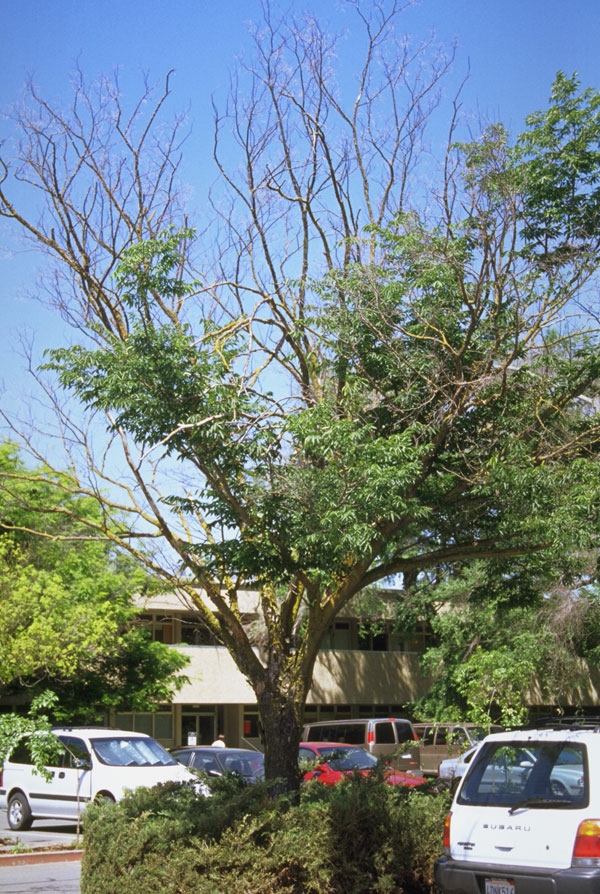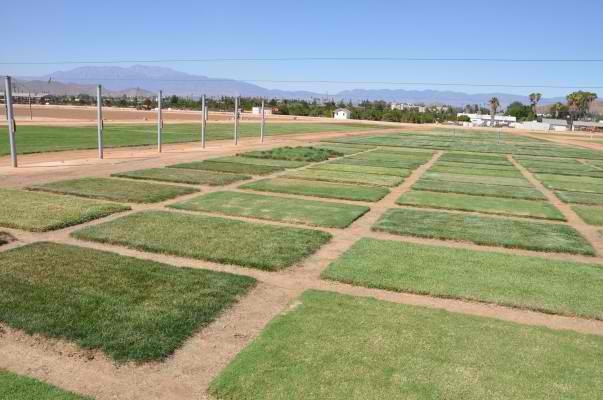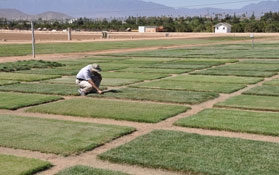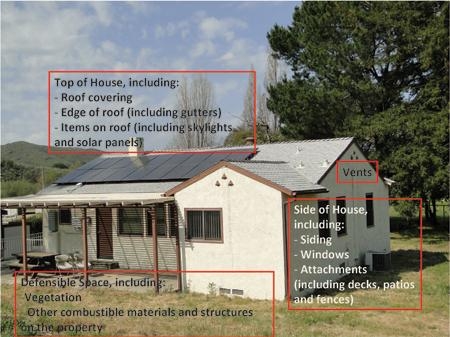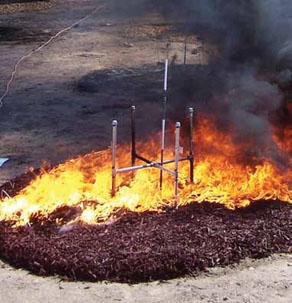Posts Tagged: landscape
Landscape trees also suffer drought consequences
Low rainfall in the state of California is stressing landscape trees in urban areas, reported the San Jose Mercury-News.
Igor Lacan, UCCE advisor in Santa Clara, Contra Costa and Alameda counties, says it's difficult to make blanket statements about which species are in trouble, since a tree's water- and heat-related health depends on its location.
Some species on a south-facing slope might show drought stress, while the same species on a north-facing slope doesn't. Stress symptoms also show up on trees planted near paved surfaces, though not near other surfaces that don't reflect heat, Lacan said. Since many tree species are fairly resilient, damage comes on slowly and may take months or years to become apparent.
But Lacan was able to conclude with a positive comment.
"The good thing is that in all likelihood mature, established trees, if climatically appropriate (for their location), will make it through ... just fine," Lacan said.
You can have a green landscape while conserving water
Turfgrass and landscape professionals will gather tomorrow, Sept. 13, at UC Riverside to learn about the latest innovations in turfgrass research and management. The 2012 Turfgrass and Landscape Research Field Day will start at 7 a.m.
One of the featured tour stops will be a research plot in which 18 plant species grown as landscape groundcovers are being evaluated for their ability to perform with low amounts of water. Dennis Pittenger, UC Cooperative Extension advisor for California’s Central Coast and South Region, and UC Cooperative Extension specialist Donald Merhaut, both based in the Department of Botany & Plant Sciences at UC Riverside, are conducting this study.
“Currently the plant materials are receiving about one-half the amount of water normally required by a tall fescue lawn, and all but three or four species appear to perform acceptably with this limited amount of water,” says Pittenger. “However, we will continue this treatment for another year to gain a full evaluation of these species' response to long-term limited irrigation.”
Residential water use totaled 5.9 million acre feet in 2005. California Assembly Bill 1881 resulted in California enacting an ordinance on January 1, 2010, reducing the evapotranspiration adjustment factor (ETAF) from 0.8 to 0.7 in new landscapes over 2,500 square feet.
David Fujino, executive director of the California Center for Urban Horticulture at UC Davis, Janet Hartin, UC Cooperative Extension advisor for San Bernardino and Los Angeles counties, and Loren Oki, UC Cooperative Extension specialist in the Department of Plant Sciences at UC Davis, received $450,000 from the California Department of Water Resources to reduce water waste and increase the landscape industry’s adoption of the new standard.
With the field assistance of William Baker and Associates, Fujino, Hartin and Oki, along with UC Cooperative Extension advisors Karrie Reid, Chuck Ingels, Mary Bianchi, and Darren Haver are setting up 30 large demonstration sites at publicly and commercially maintained landscape locations throughout the state that exemplify research-based best management practices. A variety of ornamental plants with varying evapotranspiration rates growing under a wide array of plant densities and microclimates are growing at the sites.
Demonstration sites can be seen at the following locations:
- Intel, Folsom
- Franchise Tax Board, Capitol Park, Sacramento,
- Stockton Golf and Country Club
- Woodbridge Golf and Country Club
- Fair Oaks Horticulture Center, Sacramento,
- Mission Oaks Parks and Recreation District, Sacramento
- City of Tracey
- University of California Santa Barbara
- City of Lakewood
- City of Murrieta
- City of Palm Desert
- Thunderbird Country Club, Rancho Mirage
- California Baptist University
- City of Santa Barbara
- City of Lompoc
At the field day, Hartin, an environmental horticulture expert, will talk about best management practices that large public and private landscape and irrigation managers can implement to meet the 0.7 ETAF for landscapes over 2,500 square feet.
Specific practices that she will discuss include hydrozoning (placing plants with similar water needs together), irrigation scheduling based on water requirements of the various zones, optimizing sprinkler system distribution uniformity, drip irrigation when appropriate, weed control and proper use of soil amendments and mulch.
The event will be held at the university’s Turfgrass Research Facility at 1060 Martin Luther King Blvd. in Riverside.
“With the addition of new research areas, UCR now has a state-of-the-art, second-to-none facility to study irrigation and salinity effects on turfgrass and landscape plants,” says James Baird, a UC Cooperative Extension specialist in the Department of Botany and Plant Sciences at UC Riverside, who is leading the field day. “UCR is addressing the challenges of maintaining turf and landscape plants with diminishing water resources by identifying: drought tolerance among new and existing germplasm; commercial products that help save water; and best management practices using recycled and alternate water sources for irrigation.”
Registration for the field day costs $100, which includes lunch. To register, view the agenda or get directions for tomorrow’s field day, go to http://ucanr.org/sites/turfgrassfieldday.
Water-efficient plants highlighted at turfgrass event
Reporter Laurie Lucas covered UC Riverside's turfgrass field day for The (Riverside) Press-Enterprise. Approximately 200 homeowners, park managers, water experts, scientists, nursery professionals and golf course supervisors attended the event. One of the 13 projects highlighted at the Turfgrass Research Facility's event examined water-efficient groundcover, including rosemary, thyme and iceplant. UC Cooperative Extension specialist Donald Merhaut commented on the plants' response to reduced water. "Most of the 18 species we grew with limited irrigation did well," he told the reporter. "But the geraniums showed the most direct heat stress." The article also highlighted trailing purple lantana, blue rug juniper, honeysuckle, vygie, grey saltbush and morning glory as other alternatives for cool-season grasses.
Exercise and thoughts
Many of us, me included, enjoy getting out of the office or house to go for a walk to get the heart pumping for a little exercise. My walks afford me a vacation from daily stress while providing me with the opportunity for an adventure through Solano’s garden oasis. I try to take a little different path each time I venture out so that I can feast my eyes on all the horticultural aspects my surroundings have on display. While I explore, I am tantalized by the immense creativity gardeners have and I am even more mesmerized by natural landscapes that somehow create art without much human intervention at all. I often forget I am “exercising” because while I move my thought stream around how visually captivating the landscape is. I enjoy the lingering uplifting effects that the gardens intrinsically inspire me. While I am out enjoying the landscapes, I find myself wishing that I was the proud parent of some of the more unique foliage I encounter. It occurs to me that the general public is an eclectic group, often times reinforcing the phrase “ignorance is bliss”. An example was seen when I walked past a front yard full of Hibiscus rosa-sinensis someone just planted in mid-October in Vallejo. I think that I have pretty liberal feelings toward gardening ignorance and personally give an A grade for those who display much effort at all. When someone plants their most favorite subject in the most incorrect place horticulturally-speaking, I tend to let it slide but sort of chuckle inside. So what if you have to pull them up in 45 days because the seasonal climate change slaughtered the whole batch? During those 45 days, I appreciated the graceful ignorance that killed them, but most especially those very first days when those Hibiscus rosa-sinensis were still in their warehouse store garden department prime.
It only takes a spark
The Las Conchas fire that recently consumed nearly 137,000 acres in Los Alamos, N.M., serves as a reminder of how quickly fire can move if given fuel. I can’t light a barbecue with matches and lighter fluid, but a small ember drifting on the wind can find so many ways to burn down people’s homes if given the right conditions.
Removal of vegetation near Los Alamos National Laboratory, which is part of the UC system, created a buffer and helped spare the lab from the Las Conchas fire, which came within 50 feet. Creating a buffer is one of many preventive measures that can be taken to protect property from wildfires.
In a wildfire-prone area, even if you have a house with a concrete tile roof and noncombustible siding, an ember landing on landscape mulch, igniting plants around the home or floating into a vent on the house or under decks may set the house ablaze, warns a UC Cooperative Extension fire expert.
“From years of observing the aftermath of fires and testing fire-resistant building materials, we have developed a much better understanding about what happens,” says Steve Quarles, UC Cooperative Extension wood performance and durability advisor.
Quarles lists six priority areas for evaluating the vulnerability of homes in fire hazard zones: the roof, vents, landscape plants, windows, decking and siding. For details on how you can reduce the threat of wildfire to your home, visit Quarles' Homeowner's Wildfire Mitigation Guide.
“We know that the zone within about five feet of the home is very important to home survival during a wildfire,” Quarles says.
Landscape mulch provides many benefits to a garden, but Quarles and his colleague Ed Smith, University of Nevada Cooperative Extension natural resource specialist, found that many types of mulch are capable of catching fire and burning. Within five feet of a house, they recommend placing only rock, pavers, brick chips or well-irrigated, low-combustible plants such as lawn or flowers.
Quarles and Smith have published a new manual comparing the relative susceptibility of eight mulch treatments to igniting and burning. To download a free copy of “The Combustibility of Landscape Mulches,” visit the UC Fire Center website.
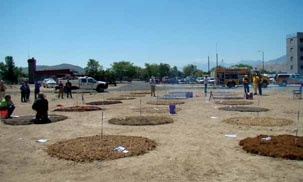
The scientists tested eight types of landscape mulches, shown in this test plot.


